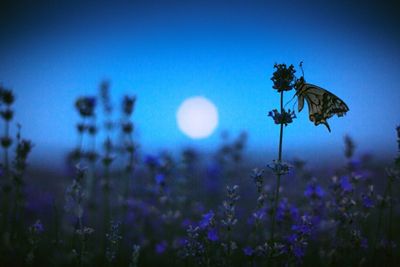What is a Moon Garden?
A moon garden is simply a garden that is meant to be enjoyed by the light of the moon, or at nighttime. Moon garden designs include white or lightly colored blooms that open at night, plants that release sweet fragrances at night, and/or plant foliage that adds a unique texture, color, or shape at night. Plants with light blooms that open at night will reflect the moonlight, making them pop out against the darkness. Some examples of excellent white blooms for moon gardens are:
Moonflower Nicotiana Brugmansia Mock orange Petunia Night blooming jasmine Cleome Sweet Autumn clematis
Some of the above-mentioned plants, such as night-blooming jasmine, petunia, and Sweet Autumn clematis, pull double duty in moon garden designs by reflecting moonlight and releasing a sweet fragrance. This fragrance is actually intended to attract nighttime pollinators, like moths or bats, but their scent adds a relaxing ambiance to moon gardens. Plants with blue, silver, or variegated foliage, such as Artemisia, blue fescue, juniper, and variegated hosta also reflect the moonlight and add interesting shape and texture to moon garden designs.
Learn How to Plant a Moon Garden
When designing moon gardens, first you will need to select an appropriate site. Moon garden layouts can be a large elaborate garden or just a small little flowerbed, but either way, you will want to select a site that is easy to access at night. Oftentimes, moon gardens are placed near a deck, patio, porch, or large window where the sights, sounds, and smells of the garden can be easily enjoyed. It is also very important that you select a site where the plants will actually be exposed to moonlight or artificial lighting, so it does not look just like any dark garden bed. This may mean spending a few nights tracking the moonlight in your garden, during the hours that you are most likely to spend time in your moon garden. Pay attention not only to where moonlight floods your garden but also to how it casts shadows. Shadows of uniquely shaped plants can add appeal to the moon garden too. As with any garden design, moon garden layouts can include trees, shrubs, grasses, perennials, and annuals. However, don’t be afraid to add other elements to the garden such as reflective gazing balls, glow-in-the-dark pots, strings of lights, and spotlights on specimen plants or another garden lighting. White rocks can also be used in beds or walkways to illuminate them in the darkness. A trickling water feature or pond full of croaking bullfrogs near the moon garden can add peaceful sounds as well.
